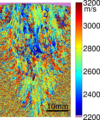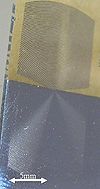Difference between revisions of "Laser ultrasonics"
From Applied Optics Wiki
(→Laser ultrasonics) |
|||
| Line 3: | Line 3: | ||
| [[Cell Imaging Using Picosecond Ultrasonics]] | | [[Cell Imaging Using Picosecond Ultrasonics]] | ||
| We have been developing an instrument for imaging the acoustic properties of living cells using high frequency ultrasound. We have taken the first images of living cells using the picosecond laser ultrasound technique | | We have been developing an instrument for imaging the acoustic properties of living cells using high frequency ultrasound. We have taken the first images of living cells using the picosecond laser ultrasound technique | ||
| − | | [[Image: | + | | [[Image:PLU_cardiacBrill.png | 100px]] |
Revision as of 08:29, 9 June 2015
Laser ultrasonics
| Cell Imaging Using Picosecond Ultrasonics | We have been developing an instrument for imaging the acoustic properties of living cells using high frequency ultrasound. We have taken the first images of living cells using the picosecond laser ultrasound technique | 
|
| Exotic Ultrasonics for the real world | We have developed a custom CMOS linear array detector for picosecond ultrasound measurements. Performing many measurements in parallel allows us to dramatically reduce the time it takes to perform each measurement. | 
|
| SRAS for materials characterisation | Spatially Resolved Acoustic Spectroscopy, it is a technique for mapping the surface acoustic wave velocity of a material. | 
|
| Cheap Optical Transducers | This is a new breed of ultrasonic transducers that are activated and read optically. CHOTs offer a range of advantages over the traditional contact transducers: remote, reliable, couplant free operation with low impact on the inspected structure, activated by light and eliminating the need of wires. | 
|
| Nanoscale Ultrasonic Transducers | We have created new ultrasonic transducers operating at the nanoscale with frequencies in the gigahertz range and with wavelengths smaller than those of visible light. These will enable the diagnostic power of ultrasonics to be used at the nanoscale. | 
|